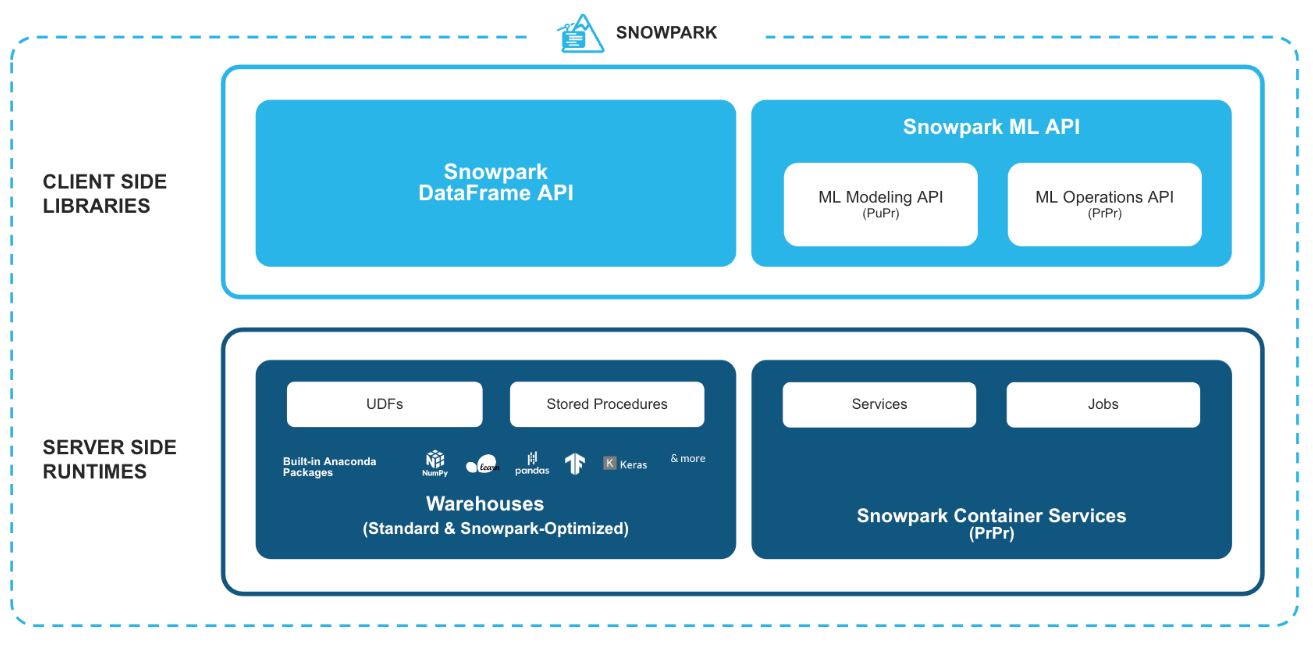Exploring Snowpark API, UDXFs, and SPROCs in Snowflake
Exploring Snowpark API, UDXFs, and SPROCs in Snowflake

Snowflake is a cloud platform that specializes in modern data, with characteristics of strong scalability, flexibility, and usability. One of the most attractive features about Snowflake is extensibility: it is relatively easy to develop custom code and then blend it into the system. Snowflake introduces the Snowpark API, User-Defined Functions (UDXFs), and Stored Procedures (SPROCs) in a much more significant way to extend native capabilities and create custom business logic to enhance your data processing workflows.
In this blog post, we’ll explore these three key features in Snowflake, focusing on how they work together to offer developers and data engineers a powerful toolkit for building complex data applications.
What is Snowpark?
Snowpark is a developer framework for Snowflake that allows you to develop, deploy, and run data pipelines and processing workflows directly within Snowflake’s cloud-based data platform using languages like Python, Scala, and Java.
Users can utilize the power of cloud on computation and scaling working natively on Snowflake data using Snowpark. The Snowpark API makes data stored in Snowflake easily accessible in a programmatic way for transformation, processing, and analysis without leaving the platform.
Working of Snowpark

Image Reference: Snowflake
Snowpark provides a client-side library as well as server-side sandbox in which Python developers will be able to write and execute code in a quite familiar environment, making use of the robust data processing capabilities of Snowflake.
The client-side library can be compared to having a toolkit in their laptop/computer, within which a python developer assembles his tools and commands in a familiar environment from which they write their Python code just like writing within any standard environment for Python.
The server-side sandbox-is a safe isolated area which is allocated on the servers of Snowflake. They get executed in this sandbox by Python developers, whenever they run their code. Well, all the hard work and what happens when you are dealing with large sets of data or complicated computations will be taken care of on the super-duper powerful servers of Snowflake, not in the developer’s own laptop/computer. This configuration not only speeds up processing but also makes handling data more efficient and adds another layer of security wherein actual data processing happens in the secure environment of Snowflake.
Key features of the Snowpark API:
DataFrame API
Snowpark introduces a DataFrame API that lets you work with and transform data, just like popular data processing libraries such as Pandas (Python) or Spark. Filter, group by, join, or carry out any other transformation directly on Snowflake tables without having to bring data out of Snowflake into an external environment.
Zero Data Movement
One of the most obvious benefits Snowpark boasts is you don’t have to move your data out of Snowflake for doing the transformations or running analytics. Everything keeps it within the Snowflake environment, which really does not bother you with these consistency issues and much of the operational overhead to be managed with moving data around.
External Functionality
Snowpark will now allow execution of external code and functions within the Snowflake environment, which is very helpful in integration with machine learning models or integrating Snowflake with third-party tools.
What are UDXFs (User-Defined Extensions)?
UDXFs in Snowflake is an extension of capabilities of Snowflake through the possibility of defining user functions and procedures. They may be written in languages such as Java, Python, or C++ – but run just like built-in ones in Snowflake, yet offer more flexibility and power for specialized tasks.
Advantages of UDXFs
Custom Business Logic
UDXFs allow developers to write business logic in a language they feel comfortable writing, giving them the flexibility needed to solve custom data problems
Performance Optimization
The UDXFs are executed in the compute environment of Snowflake; therefore, you can take advantage of Snowflakes’ scalability and performance optimizations.
What are SPROCs (Stored Procedures) in Snowflake?
Stored Procedures (SPROCs) is yet another feature of Snowflake that allows encapsulation of logic into reusable server-side procedures. Using SPROCs, you can carry out complex business logic and workflows directly within Snowflake, which thereby helps in increasing performance without having to resort much towards using outside systems or applications.
Advantages of SPROCs:
Code Reusability
SPROCs encapsulate logic in one place that is the case making your code more maintainable and reusable across multiple applications or data pipelines.
Automation
SPROCs are particularly well suited to multi-stage workflows that require little manual intervention, and therefore are great for improving the operational efficiency.
Error Handling
SPROCs, with proper error handling and transaction management, can ensure that your operations of data are safely done and also consistently.
How Snowpark API, UDXFs, and SPROCs Work Together
While individually great, Snowpark, UDXFs and SPROCs can be particularly powerful in accord. You would load big datasets in Snowflake using the DataFrame API available in Snowpark and then call a UDXF to apply some particular custom logic which Snowflake’s built-in SQL functions cannot handle, like machine learning predictions, or custom statistical calculations. Perhaps you want a stored procedure to orchestrate the flow of a complex data pipeline, pull in data, trigger UDXFs to process that data, and then apply additional logic or database operations like inserts, updates, or some data cleanup tasks.
Conclusion
The Snowpark API, UDXFs, and SPROCs provide an expansive resource of tools that developers can use to extend or automate data workflows in the context of Snowflake. Using these features together is supposed to make it easier to integrate custom business logic while optimizing performance and creating robust data pipelines and applications. Whether you are writing complex transformations using Snowpark, defining custom functions using UDXFs, or automating workflows through SPROCs, Snowflake gives you the flexibility and scalability you need to meet the demands of modern data applications without hassle with infrastructure management.